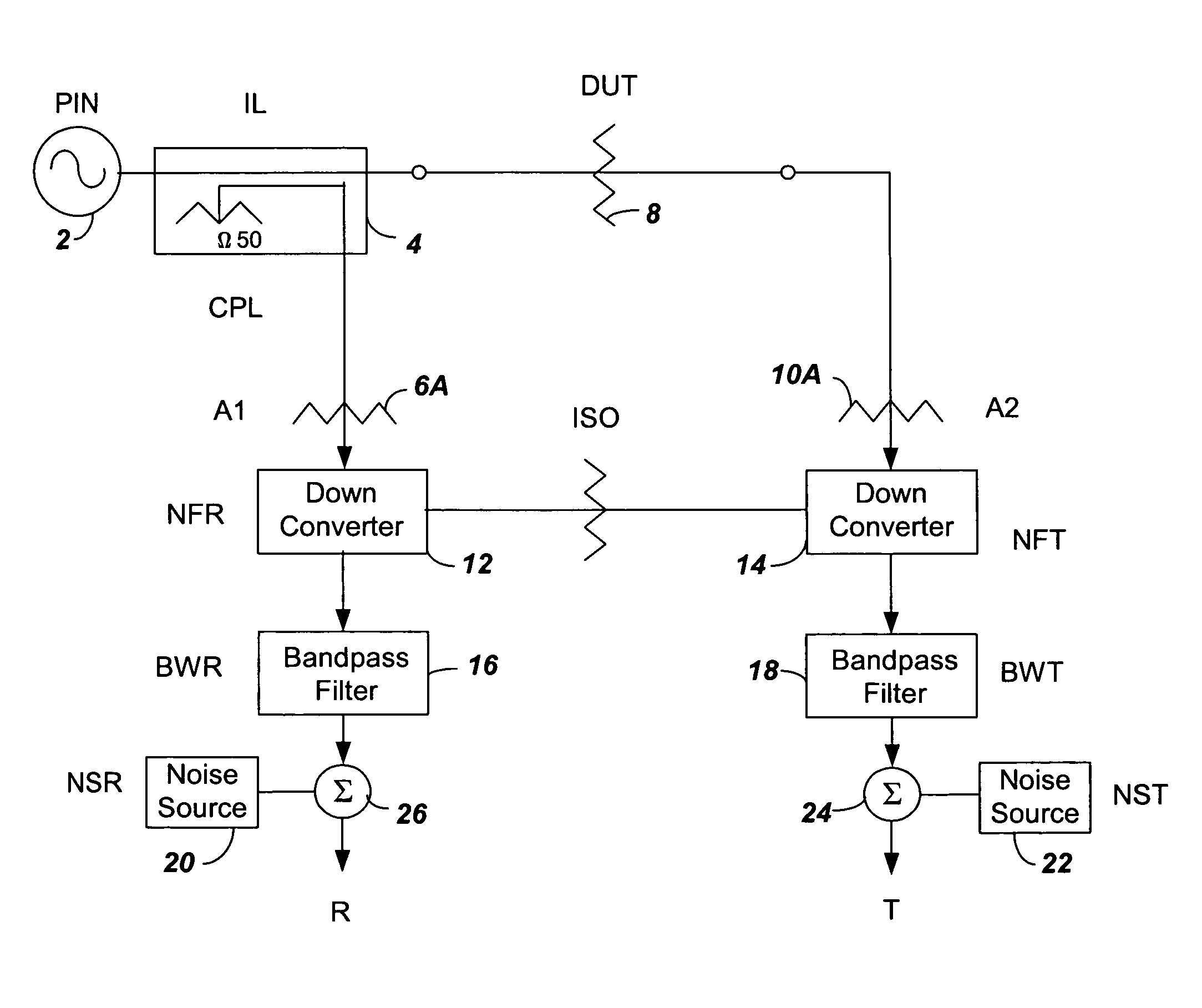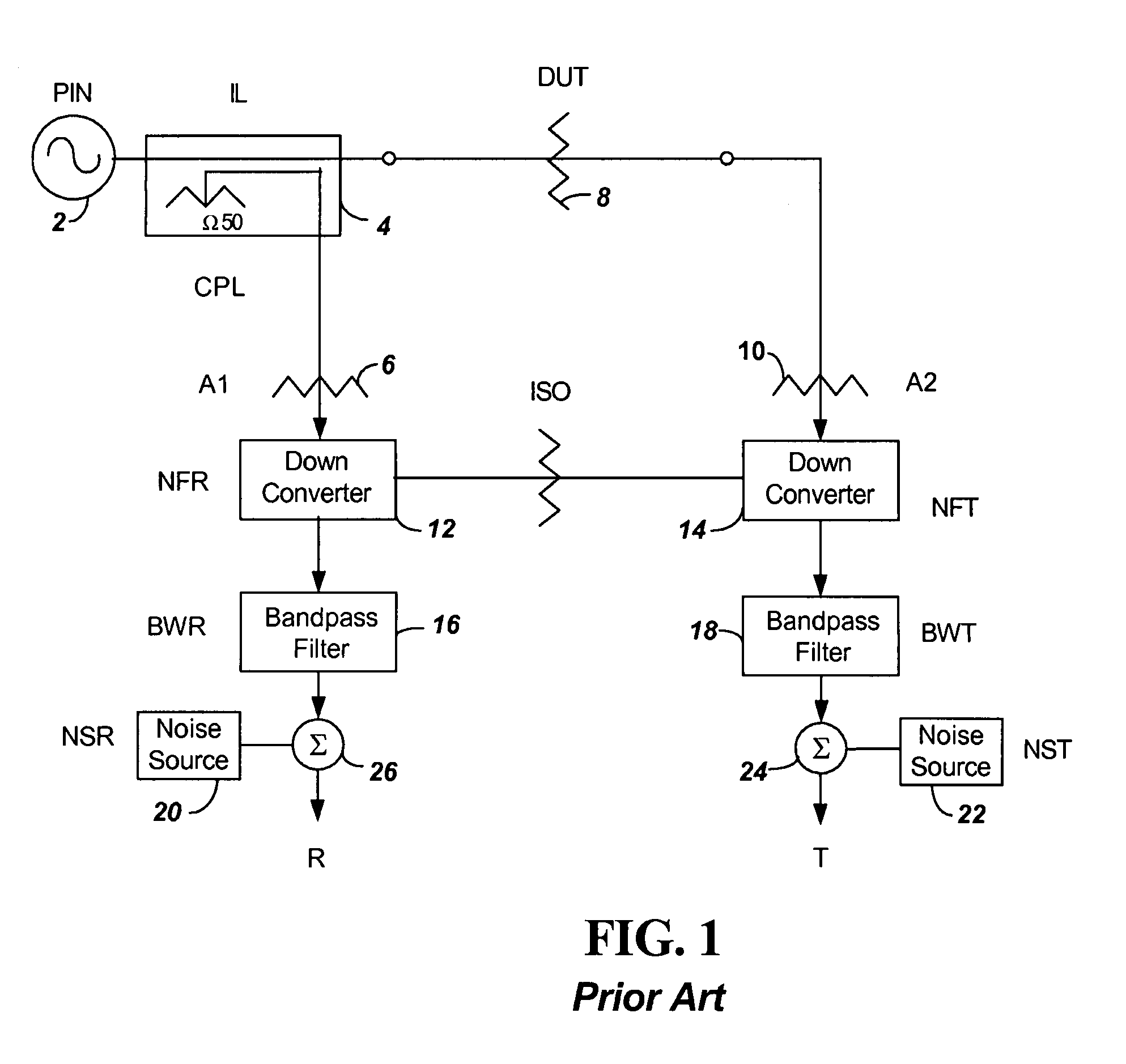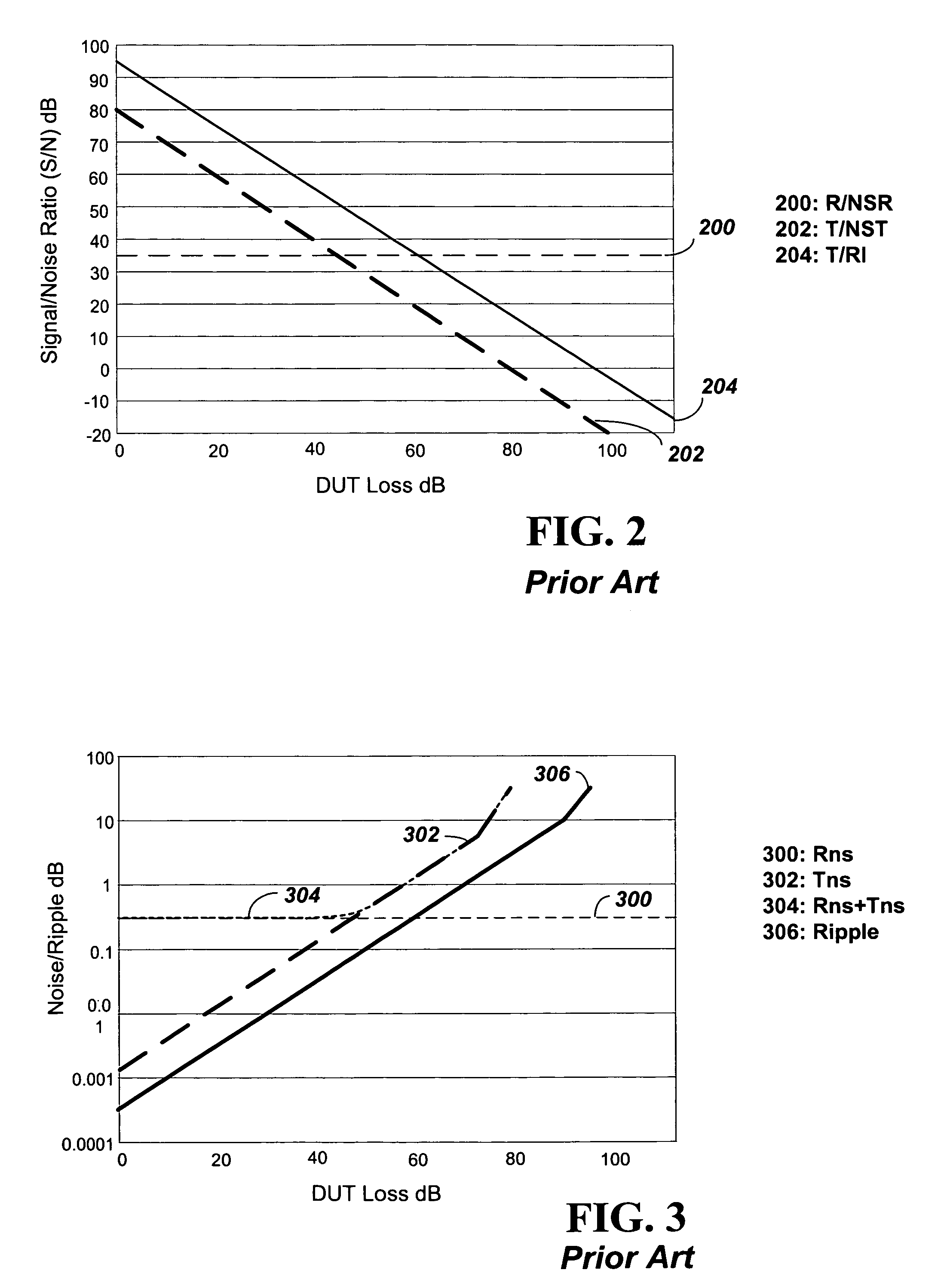Adaptive method used to overcome channel to channel isolation
a channel isolation and adaptive technology, applied in the direction of resistance/reactance/impedence, instruments, measurement devices, etc., can solve the problems of inherently high isolation cost, more) measurement channels of the vna to be designed with inherently high isolation, and achieve the effect of reducing isolation requirements
- Summary
- Abstract
- Description
- Claims
- Application Information
AI Technical Summary
Benefits of technology
Problems solved by technology
Method used
Image
Examples
first embodiment
1. First Embodiment
[0057]In a first embodiment of the present invention, A1 is changed to allow T / R1=R / NSR+Delta instead of T / R1+T / NST+Delta. One advantage that this provides is to allow the noise due to Rns to be at a minimum for DUT=45.4 dB. The equations for A1 and A2 are rederived as follows:
T / R1=R / NSR+Delta
T−R1=R−NSR+Delta
R1=R−ISO
T−R+ISO=R−NSR+Delta
T+ISO=2*R−NSR+Delta
2*R=T+ISO−NSR−Delta
R=(T+ISO+NSR−Delta) / 2
R=PIN−CPL−A1 (Determined From FIG. 4)
PIN−CPL−A1=(T+ISO+NSR−Delta) / 2 (By setting R=R in last 2 equations)
A1=PIN−CPL−(T+ISO+NSR−Delta) / 2
A1=PIN−CPL−PIN / 2+(IL+DUT+A2+Delta−ISO−NSR) / 2
A1=PIN / 2−CPL+(IL+DUT+A2+Delta−ISO−NSR) / 2 (Equation 2 for A1)
[0058]Applying the values from the previous, non-limiting example of NFR=NFT=29 dB, BWR=BWT=23 KHZ, NSR=101.4 dBm, PIN=9 dBm, IL=4 dB, CPL=14 dB, ISO=50 dB and Delta=+15 dB we determine A1 as follows:
A1=PIN / 2−CPL+(IL+DUT+A2+Delta−ISO−NSR) / 2 (From Equation 2 for A1)
A1=+9 / 2−1 4+(+4+DUT+26+15+50−(−101.4) / 2
A1=DUT / 2+38.7
[0059]This equation shows...
second embodiment
2. Second Embodiment
[0063]In a second embodiment of the present invention, a slight reduction in total noise can be realized if conditions are reverted back to T / R1=T / NST+Delta for DUT>45.4 dB. The noise reduction occurs where Tns=Rns at DUT=45.4 dB.
[0064]FIG. 7 shows a plot of S / N ratio in dB for three different signals for three different measured signals versus DUT loss in dB with A1 being a variable attenuator that tracks the DUT value only up until DUT=45.4 dB. First, a plot 700 of the reference channel signal to noise ratio R / NSR is provided vs. DUT loss. Second, a plot 702 of the test channel signal to noise ratio T / NST is provided vs. DUT loss. Third a plot 704 of the test channel signal to interfering signal T / RI is provided vs. DUT loss.
[0065]FIG. 8 shows a plot of converted noise signals and ripple versus DUT loss in dB with the variable A1 attenuator that tracks the DUT loss. First, a plot 800 of the converted reference channel S / N Rns is provided vs. DUT loss. Second, a...
third embodiment
3. Third Embodiment
[0067]For a further embodiment of the present invention, the value of A2 is altered to create a greater dynamic range for the VNA. The value of A2 in previous embodiments described has been fixed due to the fact that a given maximum input to the test channel down converter of −21 dBm and given that T=PIN−IL−DUT−A2 forces A2 to be PIN−IL−DUT+21. For the minimum value of DUT of 0, this forces A2 to be +9−4−0+21=26 dB. If A2 is allowed to go from 26 dB to 0 dB when the DUT goes from 0 dB to 26 dB, then the maximum input of the test channel would satisfy the maximum input of −21 dBm. This provides the benefit of an increase of 26 dB of dynamic range. With A2 modified as described, the equations for A1 and A2 are changed as follows:
A2=PIN−IL−DUT−T (From Equation 1 for A2)
A2=PIN−IL−DUT+21 (With T=−21 dBm under the new conditions)
A1=PIN / 2−CPL+(IL+DUT+A2+Delta−ISO−NSR) / 2 (From Equation 2 for A1)
A1=PIN / 2−CPL+(IL+DUT+(PIN−IL−DUT+21)+Delta−ISO−NSR) / 2 (by substituting A2)
A1...
PUM
 Login to View More
Login to View More Abstract
Description
Claims
Application Information
 Login to View More
Login to View More - R&D
- Intellectual Property
- Life Sciences
- Materials
- Tech Scout
- Unparalleled Data Quality
- Higher Quality Content
- 60% Fewer Hallucinations
Browse by: Latest US Patents, China's latest patents, Technical Efficacy Thesaurus, Application Domain, Technology Topic, Popular Technical Reports.
© 2025 PatSnap. All rights reserved.Legal|Privacy policy|Modern Slavery Act Transparency Statement|Sitemap|About US| Contact US: help@patsnap.com



